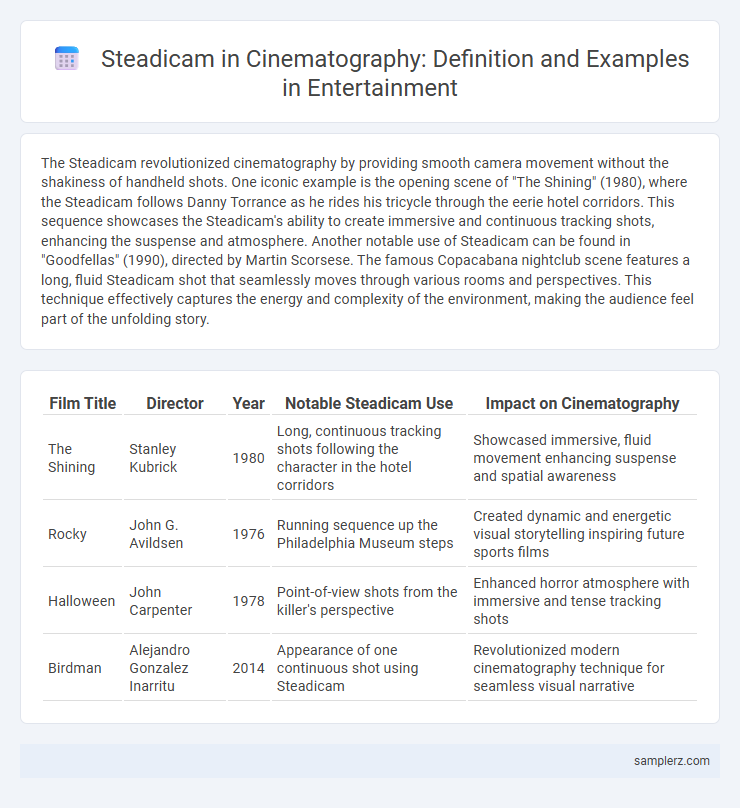The Steadicam revolutionized cinematography by providing smooth camera movement without the shakiness of handheld shots. One iconic example is the opening scene of "The Shining" (1980), where the Steadicam follows Danny Torrance as he rides his tricycle through the eerie hotel corridors. This sequence showcases the Steadicam's ability to create immersive and continuous tracking shots, enhancing the suspense and atmosphere. Another notable use of Steadicam can be found in "Goodfellas" (1990), directed by Martin Scorsese. The famous Copacabana nightclub scene features a long, fluid Steadicam shot that seamlessly moves through various rooms and perspectives. This technique effectively captures the energy and complexity of the environment, making the audience feel part of the unfolding story.
Table of Comparison
| Film Title | Director | Year | Notable Steadicam Use | Impact on Cinematography |
|---|---|---|---|---|
| The Shining | Stanley Kubrick | 1980 | Long, continuous tracking shots following the character in the hotel corridors | Showcased immersive, fluid movement enhancing suspense and spatial awareness |
| Rocky | John G. Avildsen | 1976 | Running sequence up the Philadelphia Museum steps | Created dynamic and energetic visual storytelling inspiring future sports films |
| Halloween | John Carpenter | 1978 | Point-of-view shots from the killer's perspective | Enhanced horror atmosphere with immersive and tense tracking shots |
| Birdman | Alejandro Gonzalez Inarritu | 2014 | Appearance of one continuous shot using Steadicam | Revolutionized modern cinematography technique for seamless visual narrative |
Iconic Steadicam Shots in Film History
The iconic Steadicam shot in "The Shining" (1980) showcases the fluid tracking of Danny Torrance riding his tricycle through the Overlook Hotel's eerie corridors, creating an immersive and suspenseful experience. Another landmark example is in "Goodfellas" (1990), where the continuous Steadicam shot guides viewers seamlessly through the Copacabana nightclub, emphasizing Henry Hill's glamorous yet dangerous lifestyle. These shots revolutionized cinematography by enabling smooth, dynamic movement while maintaining stability, enhancing storytelling through visual immersion.
Steadicam Masterpieces: Scene Breakdown
The Steadicam revolutionized cinematography by enabling smooth, dynamic shots without the need for tracks or dollies. Iconic scenes like the Copacabana tracking shot in Martin Scorsese's "Goodfellas" showcase the Steadicam's ability to immerse viewers through continuous, fluid movement. Another masterpiece includes the opening shot of "The Shining," where the Steadicam gracefully follows the car through winding roads, enhancing the film's eerie atmosphere.
Notable Steadicam Moments in Blockbuster Movies
Notable Steadicam moments in blockbuster movies include the iconic tracking shots in "The Shining," where the camera follows Danny Torrance through the Overlook Hotel's corridors with smooth, fluid motion. In "Birdman," the Steadicam creates the illusion of continuous takes, immersing viewers in the protagonist's chaotic world. The flawless chase scenes in "The Bourne Ultimatum" also rely heavily on Steadicam work, enhancing the intensity and realism of the action sequences.
Steadicam Innovations in Oscar-Winning Films
Steadicam technology revolutionized cinematography with Oscar-winning films like "The Shining" (1980) and "Birdman" (2014), showcasing seamless, fluid camera movements that create immersive storytelling. The innovation of gyroscopic stabilization in Steadicam systems enabled dynamic tracking shots without the shakiness of handheld cameras. This advancement continues to influence modern cinematic techniques, elevating visual narrative through precision and creative freedom.
Steadicam Use in Action Sequences: Top Examples
Steadicam techniques revolutionized action sequences by enabling smooth, dynamic shots that immerse viewers in the intensity of the scene. Notable examples include the hallway fight in "The Shining," where Steadicam captures fluid, suspenseful movement, and the high-octane chase in "The Bourne Identity" that combines speed with stability. These iconic uses demonstrate how Steadicam enhances storytelling by providing continuous, immersive perspectives without sacrificing camera stability.
Celebrated Steadicam Work in One-Take Scenes
The film "Birdman" showcases celebrated Steadicam work with its continuous one-take scenes that create an immersive and fluid narrative experience. Alejandro G. Inarritu's use of Steadicam allowed for seamless transitions and dynamic camera movements, capturing the actors' performances in real-time. This technique enhances the storytelling by maintaining tension and intimacy throughout the movie's visually complex sequences.
Steadicam in Music Videos: Memorable Examples
Steadicam technology revolutionized music video cinematography by enabling smooth, dynamic shots that emphasize movement and rhythm. Iconic examples include Michael Jackson's "Smooth Criminal," where the seamless tracking shots create an immersive experience, and Foo Fighters' "Big Me," which uses Steadicam to enhance narrative flow. These in-camera stabilization techniques allow directors to capture fluid performances and choreographed sequences, elevating the visual storytelling in music videos.
Groundbreaking Steadicam Use in TV Series
The TV series "The Walking Dead" revolutionized cinematography with groundbreaking Steadicam use, delivering immersive and fluid tracking shots that enhanced horror storytelling. By employing Steadicam techniques, the show captured intense character movements in confined environments, creating a visceral viewer experience. This innovative application set new standards for dynamic camera work in television productions.
Directors Known for Steadicam Storytelling
Directors like Steven Spielberg and Paul Thomas Anderson are renowned for their innovative use of Steadicam in cinematography, creating fluid and immersive storytelling experiences. Spielberg's iconic tracking shots in films such as "The Shining" exemplify Steadicam's ability to enhance suspense and spatial awareness. Anderson's dynamic use of Steadicam in "Boogie Nights" and "There Will Be Blood" seamlessly blends character movement with intricate set design, showcasing the technology's storytelling potential.
The Evolution of Steadicam Techniques in Modern Cinema
The evolution of Steadicam techniques in modern cinema is exemplified by iconic scenes such as the continuous tracking shot in Martin Scorsese's "Goodfellas," showcasing smooth, fluid movement that enhances narrative immersion. Advances in Steadicam technology and operator skill have enabled complex choreography in films like "Birdman," where seamless long takes blur the line between scene transitions. These innovations in camera stabilization continue to redefine visual storytelling by allowing dynamic shots that maintain stability and precision.

example of steadicam in cinematography Infographic
 samplerz.com
samplerz.com